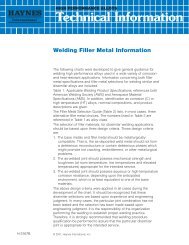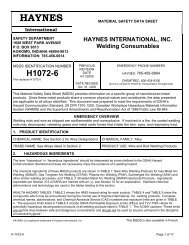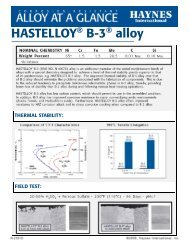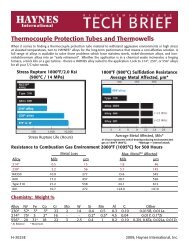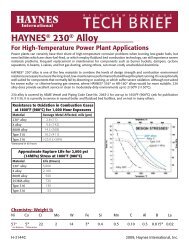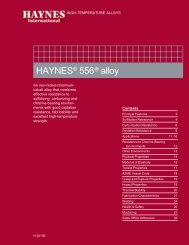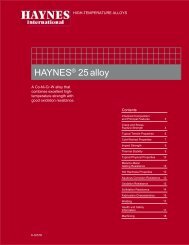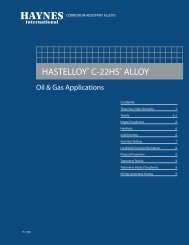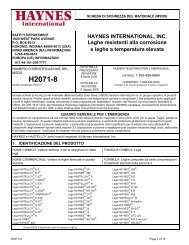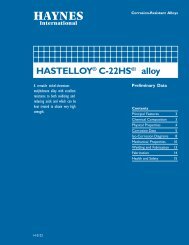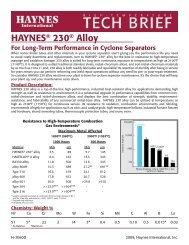P:\P25065\H-# Literature\H-2082 - Haynes International, Inc.
P:\P25065\H-# Literature\H-2082 - Haynes International, Inc.
P:\P25065\H-# Literature\H-2082 - Haynes International, Inc.
- No tags were found...
You also want an ePaper? Increase the reach of your titles
YUMPU automatically turns print PDFs into web optimized ePapers that Google loves.
Typical Tensile Data, All-Weld MetalTest Ultimate Yield Strength Elongation inWeld Temperature Tensile Strength, at 0.2% Offset, 2 in. (50.8 mm),Type °F °C ksi* ksi* %GTAW Room - 133 95 10GMAW Room - 132 89 17(Short)GMAW Room - 123 85 18(Spray)SMAW Room - 134 93 161000 - 100 61 31* ksi can be converted to MPa (megapascals) by multiplying by 6.895.Typical Impact Strength, WeldmentsV-Notch Impact StrengthRoom TemperatureWeld Type ft.-lb. JoulesGTAW 94 127SMAW 42 57Typical Bend Test Data, Welded PlateFace BendSide BendWeld Type 2T 3T 2T 3TGMAW (Short) Failed Passed Failed PassedGMAW (Spray) Failed Passed Failed PassedSMAW - Passed - -Duplicate specimens, 3/4 in. (19.10 mm) thick. Tested using AWS Specification 5.11 as a guide.HEALTH AND SAFETYWelding can be a safe occupation.Those in the weldingindustry, however, should beaware of the potential hazardsassociated with welding fumes,gases, radiation, electric shock,heat, eye injuries, burns, etc.Also, local, municipal, state, andfederal regulations (such asthose issued by OSHA) relativeto welding and cutting processesshould be considered.Nickel-, cobalt-, and iron-basealloy products may contain, invarying concentration, thefollowing elemental constituents:aluminum, cobalt, chromium,copper, iron, manganese,molybdenum, nickel andtungsten. For specific concentrationsof these and other elementspresent, refer to the MaterialSafety Data Sheets (MSDS)available from <strong>Haynes</strong> <strong>International</strong>,<strong>Inc</strong>.Inhalation of metal dust or fumesgenerated from welding, cutting,grinding, melting, or drosshandling of these alloys maycause adverse health effectssuch as reduced lung function,nasal and mucous membraneirritation. Exposure to dust orfumes which may be generated inworking with these alloys mayalso cause eye irritation, skinrash and effects on other organsystems.The operation and maintenanceof welding and cutting equipmentshould conform to the provisionof American National StandardANSI/AWS Z49.1, "Safety inWelding and Cutting". Attentionis especially called to Section 4(Protection of Personnel) and 5(Health Protection and Ventilation)of ANSI/AWS Z49.1.Mechanical ventilation is advisableand, under certain conditionssuch as a very confinedspace, is necessary duringwelding or cutting operations, orboth, to prevent possible exposureto hazardous fumes, gases,or dust that may occur.ULTIMET ® alloy 16




